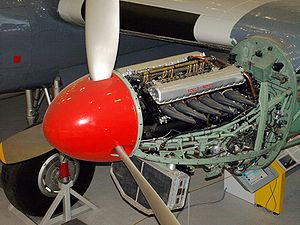
An aircraft engine is the component of the propulsion system for an aircraft that generates mechanical power. Aircraft engines are almost always either lightweight piston engines or gas turbines, except for small multicopter UAVs which are almost always electric aircraft.
In commercial aviation, the major players in the manufacturing of turbofan engines are Pratt & Whitney, General Electric, Rolls-Royce, and CFM International (a joint venture of Safran Aircraft Engines and General Electric).
In general aviation, the dominant manufacturer of turboprop engines has been Pratt & Whitney.
In this entry, for clarity, the term "inline engine" refers only to engines with a single row of cylinders, as used in automotive language, but in aviation terms, the phrase "inline engine" also covers V-type and opposed engines (as described below), and is not limited to engines with a single row of cylinders. This is typically to differentiate them from radial engines. A straight engine typically has an even number of cylinders, but there are instances of three- and five-cylinder engines. The greatest advantage of an inline engine is that it allows the aircraft to be designed with a low frontal area to minimise drag. If the engine crankshaft is located above the cylinders, it is called an inverted inline engine: this allows the propeller to be mounted high up to increase ground clearance, enabling shorter landing gear. The disadvantages of an inline engine include a poor power-to-weight ratio, because the crankcase and crankshaft are long and thus heavy. An in-line engine may be either air-cooled or liquid-cooled, but liquid-cooling is more common because it is difficult to get enough air-flow to cool the rear cylinders directly. Inline engines were common in early aircraft; one was used in the Wright Flyer, the aircraft that made the first controlled powered flight. However, the inherent disadvantages of the design soon became apparent, and the inline design was abandoned, becoming a rarity in modern aviation.